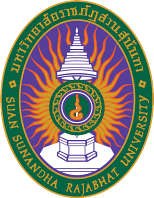Relationship Between Cash Flow and Profitability of Listed in The Stock Exchange of Thailand
Keywords:
Cash Flow, ProfitabilityAbstract
This study aimed 1) to study the cash flow and profitability listed in the Stock Exchange of Thailand and 2) to find the relationship between cash flow and profitability listed in the Stock Exchange of Thailand. It selected data from 304 of 486 companies regarding the complete data factors collected from 5 years of financial statement and annual report between 2560 – 2564 (B.E.). Descriptive statistics which were mean, maximum, minimum, and standard deviation, and inferential statistics, which were multiple regression, were used to analyze the relationship between cash flow and profitability at a 0.05 significant level.
The result of the study found that 1) the average free cash flow was 5,568,697.34 Baht and, the standard deviation was 29,331,138.36, the average cash flow operating was 3,085,175.85 Baht. Furthermore, the standard deviation was 18,070,560.30, the average net profit margin was 7.92, and standard deviation was 42.35, the average gross profit margin was 25.85, and average standard deviation was 17.42, the average return on assets was 4.53, and the standard deviation was 7.47, average return on equity was 8.03, and standard deviation was 14.97, respectively. In addition, 2) result from hypothesis testing found average free cash flow and cash flow operating have a relationship with profitability which were gross profit margin, net profit margin, return on assets, and return on equity of listed companies on the Stock Exchange of Thailand. Therefore, the business should consider keeping a small amount of free cash flow and focus on income cash which should be more than expense cash from the operation. As a result, the process will have a positive cash flow, affecting the business's profitability and investment decisions from investors.
References
ณัฎฐนันท์ กุลจิรัฐิติกาล และ ศิริพร กาญจนสุทธิแสง. (2549). การศึกษาความสัมพันธ์ระหว่างอัตราส่วนกระแสเงินสดกับความสามารถในการทำกำไรในอนาคต: บริษัทจดทะเบียนในตลาดหลักทรัพย์แห่งประเทศไทย หมวดอุตสาหกรรมอาหารและเครื่องดื่ม (รายงานวิจัย). สถาบันวิจัยและให้คำปรึกษาแห่งมหาวิทยาลัยธรรมศาสตร์.
ตลาดหลักทรัพย์แห่งประเทศไทย. (2564). รายชื่อบริษัทจดทะเบียนในตลาดหลักทรัพย์. ค้นเมื่อ 12 มีนาคม 2564, จาก https://www.set.or.th/th/company/companylist.html
เพชรี ขุมทรัพย์. (2546). วิเคราะห์งบการเงิน: หลักและการประยุกต์. กรุงเทพฯ: ทีพีเอ็นเพรส.
เพ็ญนิภา พรหมโคตร และ นงค์นิตย์ จันทร์จรัส. (2560). กระแสเงินสด ผลตอบแทนของหลักทรัพย์ และผลการดำเนินงานของบริษัทจดทะเบียนในตลาดหลักทรัพย์ เอ็ม เอ ไอ. วารสารบริหารธุรกิจและการบัญชี มหาวิทยาลัยขอนแก่น, 1(3), 35-50.
ไพฑูรย์ กอบกาญจนพฤติ. (2554). ความสัมพันธ์ระหว่างกระแสเงินสดกับราคาตลาดของหลักทรัพย์ของบริษัทจดทะเบียนในตลาดหลักทรัพย์ เอ็ม เอ ไอ (วิทยานิพนธ์บัญชีมหาบัณฑิต). มหาวิทยาลัยรังสิต.
สภาวิชาชีพบัญชีในพระบรมราชูปถัมภ์. (2561). มาตรฐานการบัญชี ฉบับที่ 7 (ปรับปรุง 2561) เรื่องงบกระแสเงินสด. กรุงเทพฯ: สภาวิชาชีพบัญชี ในพระบรมราชูปถัมภ์.
Ali, U., Ormal, L., & Ahmad, F. (2018). Impact of free cash flow on profitability of the firms in Automobile sector of Germany. Journal of Economics and Management Sciences, 1(1), 57-67.
Amuzu, M. S. (2010). Cash flow ratio as a measure of performance of listed companies in emerging economies: The Ghana example. Unpublished PhD dissertation. Retrieved March, 12, 2021, from http://stclements.edu/grad/gradmaxw.pdf
Bhandari, S. B. & Iyer, R. (2013). Predicting business failure using cash flow statement based measures. Managerial Finance, 39(7), 667-676.
Habib, A. (2011). Audit firm industry specialization and audit outcomes: Insights from academic literature. Research in Accounting Regulation, 23(2), 114-129.
Hackel, K. S., Livnat, J., & Rai, A. (2000). A free cash flow investment anomaly. Journal of Accounting, Auditing & Finance, 15(1), 1-24.
Jensen, M. C. (1986). Agency costs of free cash flow, corporate finance, and takeovers. The American economic review, 76(2), 323-329.
Kamran, M. R., Zhao, Z., & Ambreen, S. (2017). Free cash flow impact on firm’s profitability: An empirical indication of firms listed in KSE, Pakistan. European Online Journal of Natural and Social Sciences, 6(1),146.
Maham, K. (2008). Model of free cash flow for shareholders. Journal of Accounting Research, 12.
Maksy, M. M. & Chen, G. T. (2014). Which Free Cash Flow Is Value Relevant? An Empirical Investigation. Journal of Accounting and Finance, 14(6), 189.
Nguyen, A., & Nguyen, T. (2018). Free cash flow and corporate profitability in emerging economies: Empirical evidence from Vietnam. Economics Bulletin, 38(1), 211-220.
Pindado, J., & De La Torre, C. (2009). Effect of ownership structure on underinvestment and overinvestment: empirical evidence from Spain. Accounting & Finance, 49(2), 363-383.
Richardson, S. (2006). Over-investment of free cash flow. Review of accounting studies, 11(2),159-189.
Wang, Y. S., Jiang, X., Liu, Z., & Wang, W. X. (2015). Effect of earnings management on economic value added: A China study. Accounting and Finance Research, 4(3), 9-19.
Downloads
Published
How to Cite
Issue
Section
License
Copyright (c) 2022 The Journal of Development Administration Research

This work is licensed under a Creative Commons Attribution-NonCommercial-NoDerivatives 4.0 International License.
บทความที่ได้รับการตีพิมพ์เป็นลิขสิทธิ์ของมหาวิทยาลัยราชภัฏสวนสุนันทา
ข้อความที่ปรากฏในบทความแต่ละเรื่องในวารสารวิชาการเล่มนี้เป็นความคิดเห็นส่วนตัวของผู้เขียนแต่ละท่านไม่เกี่ยวข้องกับมหาวิทยาลัยราชภัฏสวนสุนันทา และคณาจารย์ท่านอื่นๆ ในมหาวิทยาลัยฯ แต่อย่างใด ความรับผิดชอบองค์ประกอบทั้งหมดของบทความแต่ละเรื่องเป็นของผู้เขียนแต่ละท่าน หากมีความผิดพลาดใดๆ ผู้เขียนแต่ละท่านจะรับผิดชอบบทความของตนเองแต่ผู้เดียว



